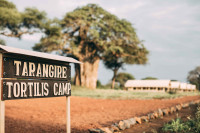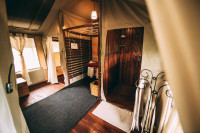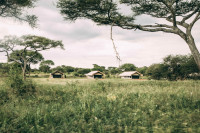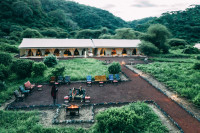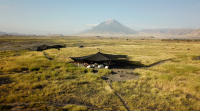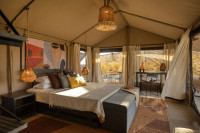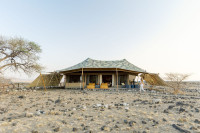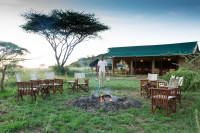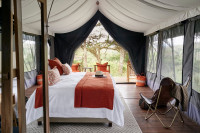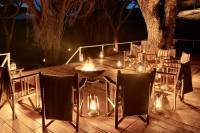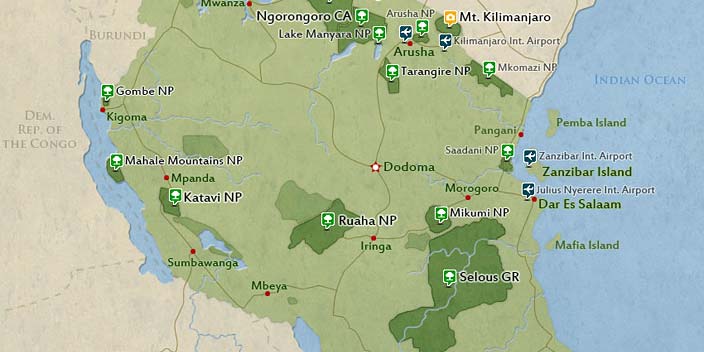
$4,857 to $5,339 pp (USD)
2 travelers on Start dateArrival
Arrival

Day 1
Drive to Tarangire National Park
Drive to Tarangire National Park
When you arrive in Tanzania, you'll leave the bustling city of Arusha and make your way to Tarangire National Park, about a three to four-hour drive away in the Manyara region. Tarangire, the sixth largest national park in Tanzania, gets its name from the Tarangire River that flows through it.
The best time to visit Tarangire is during the long dry season from June to October, when the park offers exceptional wildlife viewing. You'll likely see large herds of elephants gathering near the riverbanks and waterholes. Tarangire is also unique for its night safaris, walking safaris, and fly camping experiences. If you're interested in adding any of these adventures to your trip, just let us know!
- Main Destination:
- Tarangire National Park
- Accommodation:
- Tarangire Tortilis Camp
- Meals & Drinks:

Day 2
Visit Lake Manyara National Park
Visit Lake Manyara National Park
After breakfast, you'll head to Lake Manyara National Park, nestled beneath the cliffs of the Manyara Escarpment along the Rift Valley. The lake’s alkaline soda attracts vibrant pink flamingos and a variety of bird species across its 230 square kilometers.
In the afternoon, you can enjoy a game drive through Lake Manyara National Park or choose from several optional activities. Consider a Treetop Canopy Walk, a walking safari, or some yoga with a view of Lake Manyara from your camp inside the park.
You’ll likely encounter hippo pods in the lake, tree-climbing lions, and large herds of elephants, wildebeest, buffalo, giraffe, zebra, warthog, and impala. With a bit of luck, you might also spot leopards and hyenas. The park is home to a wide range of primates, including vervet monkeys and baboons.
- Main Destination:
- Lake Manyara National Park
- Accommodation:
- Lake Manyara Tortilis Camp
- Meals & Drinks:

Day 3
Drive to Lake Natron
Drive to Lake Natron
After leaving Lake Manyara National Park, you'll head towards Lake Natron, a gem often overlooked in the northern Tanzania safari circuit. Lake Natron is renowned for its Hominid footprints, being the largest breeding ground for lesser flamingos, and hosting Ol Doinyo Lengai, the world's only active carbonatite volcano.
You'll spend the night at Lake Natron Camp, an eco-friendly camp with just 10 spacious tents and a lovely natural, spring-fed swimming pool. Depending on your arrival time, you might enjoy a sundowner at the camp or immediately start exploring the area with your guide, on foot, or by mountain bike.
If your schedule allows, we suggest staying an extra night to fully experience all that Lake Natron has to offer.
- Main Destination:
- Lake Natron
- Accommodation:
- Lake Natron Camp
- Meals & Drinks:

Day 4
Drive to Serengeti National Park
Drive to Serengeti National Park
Starting early, you’ll have the chance to enjoy one last activity at Lake Natron Camp before heading to the Serengeti.
If you missed it the day before, we recommend taking a morning walk along the lake shore to see the lesser flamingos that feed on the algae in this soda lake. Lake Natron is the main breeding ground for about 75% of the world’s lesser flamingo population.
The lake’s surrounding flats feature small streams, lakes, and hills, creating various habitats for birds that thrive in this alkaline environment. With over 250 bird species calling Lake Natron home, many can be spotted from the camp or with a short walk.
Afterward, you’ll drive to the Serengeti, Tanzania’s most renowned national park. Known for its incredible wildlife viewing, the Serengeti is famous for hosting the Great Migration, one of the most spectacular wildlife events on the planet.
- Main Destination:
- Serengeti National Park
- Accommodation:
- Kiota Camp
- Meals & Drinks:

Day 5
Explore Serengeti National Park
Explore Serengeti National Park
Spend a full day exploring the central Serengeti from the delightful Kiota Camp, a top-notch tented camp offering breathtaking panoramic views of the surroundings.
While the Serengeti might be famous for its seemingly endless grassy plains, it actually boasts a diverse range of landscapes, including acacia forests, riverine vegetation, soda lakes, and granite mountains.
Though the Great Migration between the Serengeti and the Masai Mara in Kenya is a major highlight, the Serengeti has much more to offer year-round. You’ll enjoy incredible wildlife, stunning landscapes, and an inviting safari atmosphere at any time of the year.
- Main Destination:
- Serengeti National Park
- Accommodation:
- Kiota Camp
- Meals & Drinks:

Day 6
Head South to the Ngorongoro Crater Rim
Head South to the Ngorongoro Crater Rim
Start your day with a morning game drive in the Serengeti before traveling south toward the renowned Ngorongoro Crater.
Your next stop is the Sanctuary Ngorongoro Crater Camp, an excellent tented camp situated on the quieter eastern side of the crater. Conveniently located near the Lemala Crater access road, you'll reach the crater floor in just 15-20 minutes from the camp. This proximity allows you to avoid the crowds that come from lodges or camps further from the access road.
While the camp doesn’t offer views of the crater itself, it is nestled in a beautiful acacia forest, where you might spot wildlife wandering around the camp.
- Main Destination:
- Ngorongoro Crater
- Accommodation:
- Sanctuary Ngorongoro Crater Camp
- Meals & Drinks:

Day 7
ExplNgorongoro Crater Floor and Departure
ExplNgorongoro Crater Floor and Departure
Start your day early with a journey to the floor of the Ngorongoro Crater, where you'll spend half the day exploring this incredible natural wonder and UNESCO World Heritage Site. The crater, with its towering 600-meter walls, offers some of the best wildlife viewing in the world. Expect to see a variety of animals, including buffalo, warthog, wildebeest, zebra, hippo, and elephant. The crater is also home to many predators such as lions, hyenas, and jackals. One of the highlights is spotting the elusive black rhinos, which are hard to find elsewhere in Tanzania.
After your time in the crater, you'll return to Arusha, marking the end of your adventure.
- Main Destination:
- Arusha (City)
- Accommodation:
- No accommodation (End of tour)
- Meals & Drinks:















